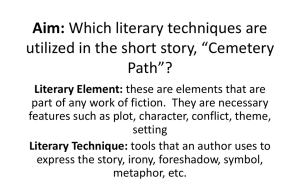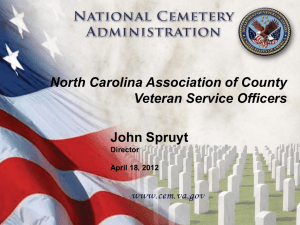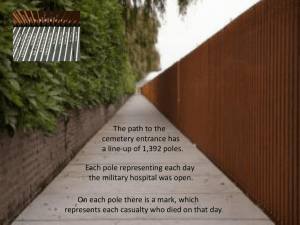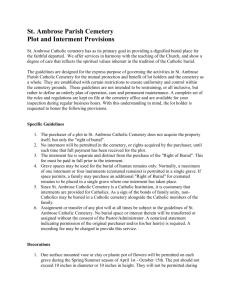THIRTEENTH COLLOQUIUM ON CEMETERIES
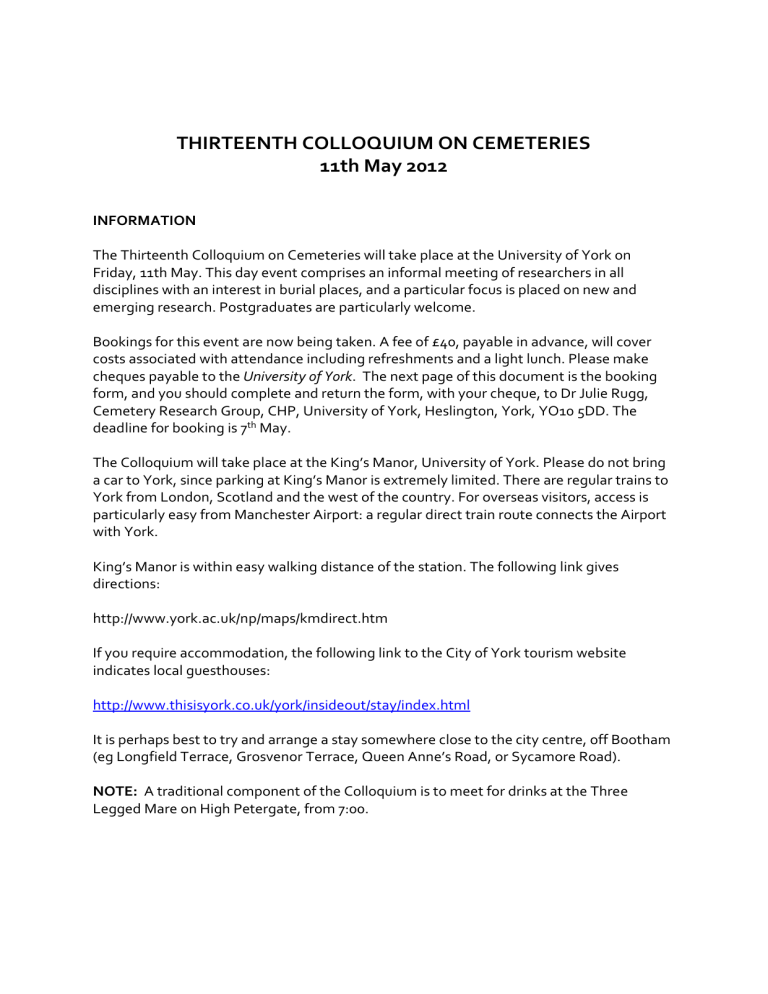
THIRTEENTH COLLOQUIUM ON CEMETERIES
11th May 2012
INFORMATION
The Thirteenth Colloquium on Cemeteries will take place at the University of York on
Friday, 11th May. This day event comprises an informal meeting of researchers in all disciplines with an interest in burial places, and a particular focus is placed on new and emerging research. Postgraduates are particularly welcome.
Bookings for this event are now being taken. A fee of £40, payable in advance, will cover costs associated with attendance including refreshments and a light lunch. Please make cheques payable to the University of York. The next page of this document is the booking form, and you should complete and return the form, with your cheque, to Dr Julie Rugg,
Cemetery Research Group, CHP, University of York, Heslington, York, YO10 5DD. The deadline for booking is 7 th May.
The Colloquium will take place at the King’s Manor, University of York. Please do not bring a car to York, since parking at King’s Manor is extremely limited. There are regular trains to
York from London, Scotland and the west of the country. For overseas visitors, access is particularly easy from Manchester Airport: a regular direct train route connects the Airport with York.
King’s Manor is within easy walking distance of the station. The following link gives directions: http://www.york.ac.uk/np/maps/kmdirect.htm
If you require accommodation, the following link to the City of York tourism website indicates local guesthouses: http://www.thisisyork.co.uk/york/insideout/stay/index.html
It is perhaps best to try and arrange a stay somewhere close to the city centre, off Bootham
(eg Longfield Terrace, Grosvenor Terrace, Queen Anne’s Road, or Sycamore Road).
NOTE: A traditional component of the Colloquium is to meet for drinks at the Three
Legged Mare on High Petergate, from 7:00.
.
The Thirteenth Colloquium on Cemeteries
BOOKING FORM
Name ………………………………………………………….
Address
(to which a receipt will be sent)
………………………………………………………….
………………………………………………………….
………………………………………………………….
………………………………………………………….
Email ………………………………………………………….
Any special dietary requirements? ………………………………………….
CONFERENCE FEE, £40
**Please make the cheques payable to THE UNIVERSITY OF YORK **
Send the cheque and the booking form to: Dr Julie Rugg, Cemetery Research Group, CHP,
University of York, Heslington, York, YO10 5DD. A receipt for payment will be issued.
Thirteenth Colloquium on Cemeteries
11th May, King’s Manor, University of York
9:15-9:30 WELCOME AND INTRODUCTIONS
9:30-10:15 ‘Casting into the great crucible of the present ferment all manner of time-honoured traditions’: burial legislation at the turn of the twentieth century
Julie Rugg
10:15-11:00 Cemetery as machine
Gian Luca Amadei
11:00-11:30 COFFEE
11:30-12:15
12:15-1:15
1:15-2:00
Robertson at the City: portrait of a cemetery superintendent
Brian Parsons
LUNCH
2:00-2:45
2:45-3:15
3:15-4:15
The management of historic cemeteries by friends’ groups
Gaelle Jolly
The Edinburgh Graveyard Project
Susan Buckham
TEA
4:15
A co-operative project in cemetery research: Mount Saint Lawrence
Cemetery, Limerick City 1855-2010
Matthew Potter and Maura Cronin
CLOSE
‘Casting into the great crucible of the present ferment all manner of time-honoured traditions’: burial legislation at the turn of the twentieth century.
Julie Rugg, Cemetery Research Group, University of York
The first of the Burial Acts were introduced in the 1850s, and discussion of this legislation generally focuses on the mid-century period. However, it is arguably the case that the most radical of the Burial Acts was the penultimate Act, passed in 1900. This Act - unlike earlier
Burial Acts – did not favour the interests of the Church of England and was decidedly secular in tone. Rather than presuming that each cemetery would be consecrated, with some unconsecrated space left available, the Act required that for each cemetery and each cemetery extension a case had to be made for consecration. Furthermore, the local parish priest would no longer benefit financially from burials taking place in the consecrated section, even those where the service was taken by another minister.
The Burial Act 1900, together with three other key pieces of legislation, radically altered the legislative landscape for burial in the twentieth century. The Cremation Act of 1902 is reasonably familiar, but this paper also discusses the Local Government Act 1894 and the hugely important but entirely overlooked Public Health (Interment) Act 1879. These four acts operating in unison looked set to dismantle a centuries-old tradition of parish burial.
However, secularity in principal did not necessarily lead to secularity in practice: exploration of the 1900 Act in operation shows continued and strong commitment to practice of consecration.
The cemetery as machine
Gian Luca Amadei, University of Kent
The advent of the Industrial Revolution in the second part of the eighteenth-century
England was fuelled by the invention of mechanical devices such as the hydraulic pump.
The adoption of this machine had a fundamental impact in trade, commerce as well as transport. Its influence eventually reached out to unusual applications such as that of the catafalque - a mechanical device based on the principle of the hydraulic pump - which became a fashionable feature in nineteenth-century Victorian necropolises. The introduction of such a mechanical innovation into the Victorian Necropolis throws open a series of questions on the matter of burial rituals and the perception of death in the nineteenth century.
Taking as case studies Kensal Green Cemetery, Highgate Cemetery and Brookwood
Cemetery, this paper will attempt to shed light on how and why these mechanical devices arrived to be used in these cemeteries in the first place. What were their purposes and use in those cemeteries? How these mechanical devices evolved? How these unemotional machines used for burial found their place in what were otherwise perceived as romantic spaces? And lastly did this process of mechanisation of the cemetery change the perception of death in nineteenth-century Britain?
Robertson at the City: portrait of a cemetery superintendent
Brian Parsons, University of Bath
The origins of superintendent can be traced back to the establishment of proprietary cemeteries in the mid-nineteenth century. Responsible for day-to-day operations including supervision of grave preparation and routine maintenance along with administration and staffing, the remit has gained complexity through increased bureaucratisation and legislation, the preference for cremation and more recently from customer focus and centralisation of the service. Whilst the contemporary function has been comparatively well documented, little has been written about the development of the occupation in the early twentieth century.
This paper examines the contribution made to the formative professionalisation process by
John Robertson, superintendent at the City of London Cemetery and Crematorium between 1913 and 1936. Drawing from cemetery committee minutes and those of the
National Association of Cemetery Superintendents (NACS), archival records and published articles, a biographical note and short assessment of his work at the City is followed by the appraisal of three areas where Robertson’s influence can be identified: the founding of
NACS in 1914; as a writer on cemetery management, and lastly, on the design of cemeteries.
The management of historic cemeteries by friends’ groups
Gaelle Jolly, University of Bath
Many historic cemeteries have only escaped from clearance or dereliction because of campaigns and direct management by friends’ groups. Despite a growing interest in cemeteries among conservation professionals in recent years, the involvement of local groups remains crucial, particularly for cemeteries of local rather than national interest.
There has however been little examination of the factors behind the involvement of friends’ groups and the resulting impact of their work on cemetery character.
Historic cemeteries are rich in meaning and local value, but they are also potentially problematic spaces due to their ‘liminal’ status. Urban cemeteries in particular may be seen to threaten order through both the presence of death amongst the living and the presence of nature within the city. This paper will suggest that strategies for dealing with this liminal quality are expressed through the development of narratives about the cemeteries and their role within the locality. In turn the stories privileged through this process impact on the management and presentation of the sites. Based on initial research into three early
Victorian cemeteries in Oxford, this paper will show how the interpretation of the history and contemporary value of cemeteries by local groups are ultimately expressed in their character and presentation. It will be argued that the reliance on volunteer groups makes local contexts particularly important in determining the future conservation of historic cemeteries.
The Edinburgh Graveyards Project
Susan Buckham, Kirkyard Consulting
The Edinburgh Graveyards Project encompasses the three kirkyards of St Cuthbert’s,
Greyfriars and Canongate and the two burial grounds of Calton Old and Calton New. The
Project draws together existing information on these sites and develops this knowledge through new research linked to the following aims: to develop a body of knowledge relating to the graveyards that will help to improve our understanding and valorisation of the graveyards; to assess the current patterns of ‘use’ of the five graveyards and the potential for positive improvement; to recommend options for improved practical care and management of the graveyards; and to examine the potential for enhanced community participation in a process of creating a more financially sustainable model of stewardship.
In order to meet these aims, the research collected new data on public perceptions of the sites which are more or less well-established ‘tourist’ destinations. The research considered possible management strategies for the sites, and in doing so collated data on the operational of a range of existing Friends’ groups. However, there is no ‘off-the-peg’ model for a Friends’ group covering more than one site, and where each site presents different interpretation challenges and opportunities. Furthermore, the need to take action is stymied by the lack of any imminent ‘threat’ to any of the sites in the project. The paper concludes with some reflections on public inclusion in the conservation of burial spaces.
A co-operative project in cemetery research: Mount Saint Lawrence Cemetery, Limerick City
1855-2010
Matthew Potter and Maura Cronin, History Department, Mary Immaculate College,
Limerick
This paper examines a project on-going at Mary Immaculate College Limerick since 2010.
Exploring the place of Mount St Lawrence Cemetery in life of Limerick city (1855 to the present), the project has four distinguishing features: (a) It involves co-operation between a third level institution, a municipal authority, and local communities; (b) It brings together seasoned and novice researchers – faculty, postgraduates and undergraduates and (c) It combines research in contemporary documentary sources, digitisation of the cemetery registers, photographing and recording of the cemetery’s monuments, and a programme of oral history interviewing. The paper examines the work of the Mount Saint Lawrence
Project over the past two years, focussing on three main themes: the ways in which the research was integrated in the final year history undergraduate programme, the preliminary findings of the register digitisation programme, and the light thrown by the photography project on changing trends in religious devotion and iconography in a Catholic cemetery in urban provincial Ireland.

